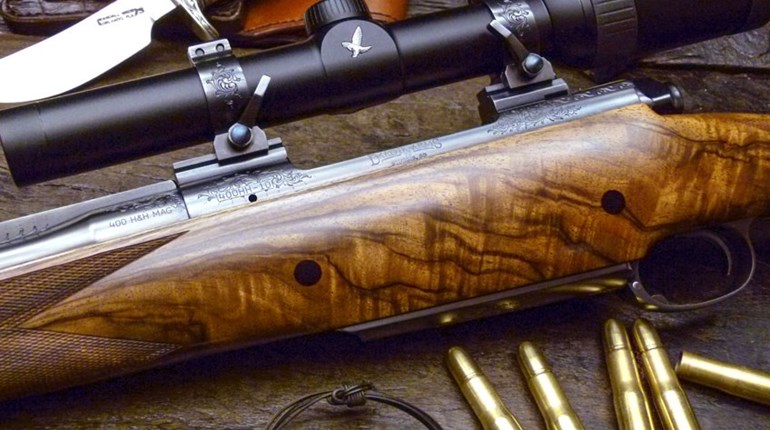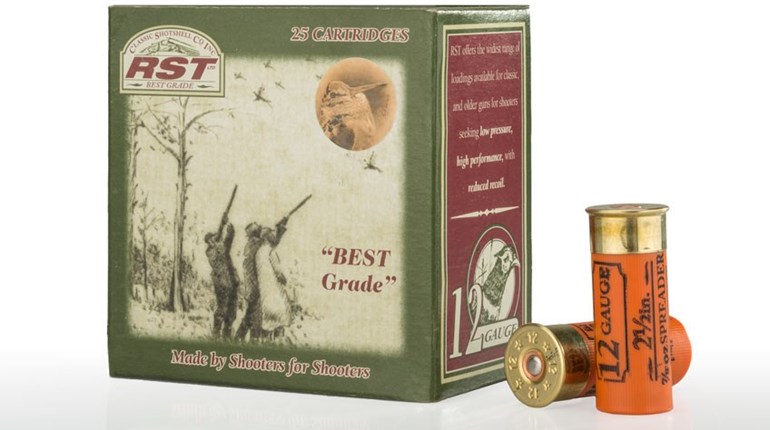
For centuries, wood has been the material of choice for both long gun and handgun stocks. Although many woods have been (and continue to be) used for firearm stocks, long experience has led most stockmakers to favor only a handful of hardwood types such as walnut. This matters because the dimensional stability of a given wood species used for a gunstock will affect the shooting accuracy of a rifle.
According to some authorities, only trees 24 inches or more in diameter should be used for gunstocks. The best wood for stocks is found in the first 5 or 6 feet of the trunk, at the junction of the stump and the roots and in the "crotch" area where the trunk splits into branches. With many walnut trees, the stump is not cut off at ground level, but dug out to take advantage of the figure in the vicinity of the roots.
Once cut to length, the stump is cut into a number of rough-sawn pieces of wood, called "blanks," each having the approximate outline of the stock prior to final shaping. There are several ways to cut blanks from the trunk. The best method is quarter sawing, but this method produces considerable waste. A modified form of quarter sawing, called "splitting," yields a greater number of blanks, as do the slab and modified slab sawing methods. Each blank ends up as a block of wood approximately 36 inches long, 15 inches wide and 3 inches thick with its ends sealed with paraffin wax.
Up to 40 percent of the weight of a newly cut stock blank is moisture; this must be reduced to around 10-12 percent before the blank can be made into a stock. Air drying is the best method of reducing moisture in stock woods, but it typically takes years. Kiln drying is a popular and faster alternative. Kiln drying is a two stage process. For the first stage, the three-inch-thick blanks are stacked with sticks separating the layers to allow air circulation. After drying, they are cut into rough blank shape, with a section about 8 inches wide to the rear tapering to about three inches wide at the front. Following this, they are again stacked with the ends sealed for final drying. After this, the stock is shaped and inletted.
Various systems are used to grade stock blanks based on considerations such as color, figure, grain flow, texture, lack of sapwood, the ability of the stock to take fine checkering and more. Grades generally range from Utility or Common at the low end to Exhibition or Special Select at the top. Some suppliers have premium grades higher than Exhibition. There is no single classification system universally accepted or used by stock wood suppliers, however.
Considerable experience is required to properly cut a block of wood into a blank, and then to make the blank into a stock. Grain orientation is critical for strength in highly stressed areas such as the pistol grip. Ideally, the grain should flow with the lines of the stress. Breakage can occur when the grain flows in the wrong direction. For example, the convoluted patterns of light and dark produce the best figure, but also signal where the wood is weak. Thus, figure should be restricted tot he area of the buttstock behind the wrist.
Stock inletting and shaping can be performed manually, with machine tools or a combination of both. In this phase, walnut quickly demonstrates why it is the first choice of stockmakers. It is easily cut with sharp tools, does not embed in rasps or files, and is not brittle—characteristics that allow the precise wood-to-metal fit that is the sine qua non of fine stockmaking.
After shaping and inletting, the stock is checkered either by hand or by machine. In this process, the surface of the wood in selected areas of the pistol grip and fore-end is cut away to form a series of intersecting lines. The pattern formed provides superior adhesion to the shooter's hands. If called for, sling swivel studs are installed at that time.
Application of the stock finish is the final phase. It serves to seal the stock against moisture, strengthen the wood fibers at the surface, and preserve the color and figure of the wood. The stock must first be smoothed with successively finer grades of sandpaper until it is free of scratches and tiny "whiskers" of wood. With many (but not all) woods, a separate sealer is applied to inhibit moisture changes. Coarse-grain woods, such as some of the walnuts, must also have their pores filled with to the level of the surrounding wood. This is frequently accomplished using thick coats of the same material to be used for final finishing; the thick filling coats are allowed to dry and then brought back to the level of the wood with fine sandpaper, leaving only the pores filled.
There are three types of preservatives used for finishing gun stocks: oil, varnish (lacquer) and synthetics such as polyurethane. Hand-rubbed tung or linseed oil finishes are beautiful, but each coat must be laboriously hand-applied, dried and smoothed, then the process repeated until the desired depth of finish is produced.
Modern synthetic finishes such as acrylics and polyurethanes apply easily and can fill, seal and finish a stock in only one or two coats. They are also very durable. Lacquer and varnish finishes offer an attractive finish, but one that is not quite as durable as synthetic finishes. Although not as durable as synthetic, lacquer, varnish and oil finishes are the easiest to repair in the event of a scratch or ding. The final finish, ranging from glossy to matte, can be obtained by using very fine abrasive paper or rubbing compound followed by a final coat of wax.






































